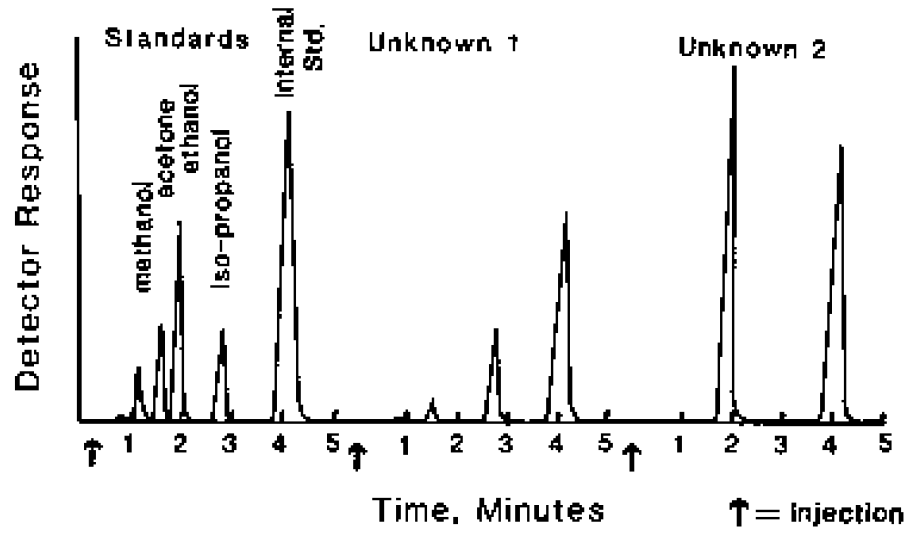2.29: Gas Liquid Chromatography (GLC)
- Page ID
- 38657
RELATED READINGS: Pages 154-165.
OBJECTIVES
Upon completion of this exercise, appropriate discussion and
related readings the student will be able to:
- Interpret a gas chromatography (GC) pattern
- Calculate the concentration of an unknown by the method of internal standardization.
PRINCIPLE
In GLC the electronic signals associated with the detectors are such that the area under a given peak is proportional to the concentration (C) of the substance being detected. In this case $$\frac{C_{u}}{A_{u}} = \frac{C_{std}}{A_{std}}$$where A is the area under the peak for the standard (std) or unknown (u). If a GLC system lacks an integrator and digital printout, you can cut the peak out and weigh it. If the detector does have a digital readout, a peak area number in arbitrary units will be printed out corresponding to each peak. The peaks are identified by their retention times.
There are many variables in the GLC (or HPLC) assay that can lead to inaccurate and imprecise analysis. These include variations in extraction efficiency, amount of sample injected, processing losses, and chromatographic errors. To minimize these errors, many chromatographic techniques employ an internal standard (I.S.). In this case, the concentration of the analyte (Cu) is related to the ratio of the peak area (or peak height) of the analyte (Au) to the peak area of the internal standard (AIS) as follows:
\[\frac{C_{u}}{\frac{A_{u}}{A_{IS}}} = \frac{C_{std}}{\frac{A_{std}}{A_{IS}}}\]
Any variation that occurs in the analysis will affect the I.S. to the same extent as it affects the analyte. So although variations in injecting the sample into the GLC system might lead to an increase or decrease in the Au, the same change would occur to the AIS, leaving ratio Au/AIS essentially unchanged. Thus, the internal standard technique is widely used whenever a suitable I.S. can be found.
MATERIALS
Sample chromatograms are found at the end of this exercise. These chromatograms resulted from an assay for alcohols using the following procedure. The student will need a balance and calculator to perform this exercise.
PROCEDURE
- Sample preparation. Pipet 200 mL of internal standard into a 12 mm x 75 mm glass tube. Add 200 mL of serum, and mix.
- Chromatographic parameters. Injection temperature, 210°C; column temperature, 100°C; detector temperature, 260°C; gas flow at 60 mL/min, with the proportions of nitrogen/air/hydrogen at 40:10:20.
- Inject 0.5 mL of sample or standard into chromatograph (don’t bend or blunt injection needle; avoid air bubbles in sample). Chromatographic run time is approximately 6 minutes.
- Determine the retention time of each of the standards, and record in the Results section on the Data Sheet.
- Identify your unknown by comparing its retention time to that of the standards.
- Cut out the peaks of the unknown and the appropriate standard and weigh them.
- Determine the concentration of the unknown and record in the Results section on the Data Sheet.
OPTIONAL EXERCISE
Repeat the calculation described on the data sheet, but use the peak heights in mm, rather than peak area. Is there any significant difference?
| DATA SHEET, EXERCISE #29 |
NAME: ___________ DATE: ___________ |
RESULTS
| Sample | Retention Time (min) |
Peak Area (mm2) |
Peak Weight (mg) |
Peak Area Ratio (A/AIS) |
|---|---|---|---|---|
| Standard Methanol |
||||
| Standard Ethanol |
||||
| Standard Isopropanol |
||||
| Internal Standard |
||||
| Unknown Alcohol (s) |
||||
| Unknown Alcohol (s) |
||||
| Internal Standard |
From the retention time, what alcohol (s) is/ (are) present in the unknown?
________________________________________________________________
CALCULATIONS
Calculate the concentration of the unknown alcohol as follows:
Cu = concentration of unknown alcohol,
Cstd = concentration of corresponding alcohol standard
Au = peak area of unknown alcohol
Astd = peak area of standard
AIS = peak area of corresponding internal standard
\[\frac{C_{u}}{\frac{A_{u}}{A_{IS}}} = \frac{C_{std}}{\frac{A_{std}}{A_{IS}}}\]
\[C_{u} = C_{std} \times \frac{\frac{A_{u}}{A_{IS}}}{\frac{A_{std}}{A_{IS}}}\]
The concentrations of the unknown alcohol(s) is/are:
__________________ \(\mu\)g/mL __________________ \(\mu\)g/mL
OPTIONAL EXERCISE
Using peak heights, the concentration of the unknown alcohol(s) are:
___________________\(\mu\)g/mL
The following chromatograms can be used for the above calculations. To weigh peaks, photocopy this page in order to have a copy to cut out.

Discussion Questions
- If the polarity of the stationary phase for this analysis were increased, how would the retention times of the alcohol’s change?
- This assay does not require any extraction of the analyte from the sample. Might this fact affect column longevity?
- How would you measure the levels of n-propanol in a sample?
- What is the chemical difference between the alcohol’s analyzed by this exercise? How does this difference relate to the observed elution pattern?
- What assumptions are made concerning the use of a particular compound as an internal standard?

